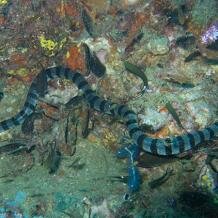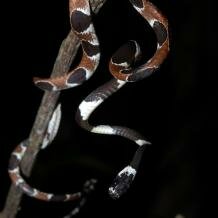Topic: Feeding in snakes and lizards
The Turtle-headed sea snake feeds on small eggs and its feeding shows intriguing similarities to the way lizards forage, and herbivorous mammals graze and browse.
Think of a snake. The common vision is a gaping mouth, fangs dripping venom and in due course a sinister bulge half-way down the body. “Anybody seen the gerbil?” Such indeed is the case, but there are many subtleties, and of course they are convergent. What of their close relatives, the lizards? While perhaps snapping at small prey (or maybe using an immense tongue, as in chameleons; again convergent with some frogs), otherwise aren’t they fairly harmless feeders? Not quite; again convergences emerge, as illustrated by the intriguing cases below.
Sea-snake feeding strategies
 Sea-snakes are a highly successful group, and given the extent of the tropical oceans perhaps they are the most abundant reptiles on earth. In any event they originated at least twice from within the otherwise terrestrial elapid snakes and show interesting convergences relating to feeding, from body form to foraging strategies. Sea-snakes of all kinds inhabit warm seas and have parallel adaptations to a predator’s life, speeding through the sea in pursuit of fish and other highly mobile food. Classic sea-snake adaptations include an eel-like body with a paddle-like tail, salt glands, a capacity to stay underwater for hours at a time and live birth (rather than laying eggs; such viviparity is rampantly convergent, especially in snakes and lizards). Sea-snakes are highly venomous and generally they are very much to be avoided (unless you mistake an octopus that ingeniously can mimic a sea-snake).
Sea-snakes are a highly successful group, and given the extent of the tropical oceans perhaps they are the most abundant reptiles on earth. In any event they originated at least twice from within the otherwise terrestrial elapid snakes and show interesting convergences relating to feeding, from body form to foraging strategies. Sea-snakes of all kinds inhabit warm seas and have parallel adaptations to a predator’s life, speeding through the sea in pursuit of fish and other highly mobile food. Classic sea-snake adaptations include an eel-like body with a paddle-like tail, salt glands, a capacity to stay underwater for hours at a time and live birth (rather than laying eggs; such viviparity is rampantly convergent, especially in snakes and lizards). Sea-snakes are highly venomous and generally they are very much to be avoided (unless you mistake an octopus that ingeniously can mimic a sea-snake).
One of the most venomous sea snakes is the banded sea krait Laticauda colubrina. The feeding strategy of male Laticauda involves hunting in groups and exploring cavities for prey. This tactic shows convergences with feeding in American water snakes, Australian file snakes and, more distantly, moray eels. In another case, the Turtle-headed sea snake Emydocephalus feeds on small eggs and not only does its mode of feeding have intriguing similarities to the way lizards forage, but even more strikingly even to the grazing and browsing of herbivorous mammals.
Egg-eating (oophagous) snakes
Emydocephalus is not the only snake to favour a diet of eggs. The Marbled sea snake Aipyurus also hoovers up small eggs. Both species have reduced dentition and a specialized jaw muscle to depress and create suction across the oral cavity. Suction feeding is itself convergent and the jaws of ant-eating scolecophidian snakes most closely resemble those of egg-eating sea-snakes. Some terrestrial snakes also eat eggs, often those of turtles or birds. These oophages include the Australian coral snake Simoselaps (an elapid) and a number of colubrid snakes, for example Dasypeltis. Notably, independently these snakes have replaced many of their upper jaw teeth with a long blade-like tooth for effectively crushing egg shells.
Striking to kill under water and on land
 The natricine snakes are a diverse sub-group of colubrids and among them are a number of aquatic species. Natricines that inhabit streams provide an excellent window into convergence, with a body form adapted for life in water and show common strategies for fish predation. Studies of how these snakes strike underwater at prey with a fast forward movement have highlighted both functional constraints (due to the viscosity of water) and convergence in striking techniques.
The natricine snakes are a diverse sub-group of colubrids and among them are a number of aquatic species. Natricines that inhabit streams provide an excellent window into convergence, with a body form adapted for life in water and show common strategies for fish predation. Studies of how these snakes strike underwater at prey with a fast forward movement have highlighted both functional constraints (due to the viscosity of water) and convergence in striking techniques.
On land it is remarkable to observe ecological convergences among various elapid snakes, especially in their mode of striking at prey. Particular parallels have been found between the strike of the deadly Australian taipan Oxyuranus and that of the equally deadly and fast-moving African black mamba (Dendroaspis); also between the African pit viper Bitis and the highly venomous Australian death adder Acanthophis.
Hinged teeth for troublesome prey
Understandably if a snake is going to strike and in some species inject venom it wouldn’t make a lot of sense if the teeth promptly collapsed, but in fact the hinged teeth of certain snakes can fold down, being attached to flexible tissue. In most cases the teeth are relatively small, quite numerous, with flattened tips and smooth surfaces. And the reason for these collapsible teeth? To deal with wriggling, hard-bodied prey, such as lizards. Hinged teeth have evolved at least three times in snakes, in two groups of colubrid snake and in a third group that includes the iridescent ‘sunbeam snake’ Xenopeltis. In the African colubrids evidently this strategy to deal with what would otherwise be intractable prey has evolved three times independently, possibly five. Nor do the convergences stop there: in Burton’s legless lizard Lialis (which is convergent on snakes; see limblessness) the same type of hinged teeth has evolved independently, and Lialis feeds on snakes and lizards (not ladders).
Another way to handle wriggling lizards is to go beyond collapsible teeth to a collapsible jaw. Uniquely among vertebrates, the bolyerine Round Island boa Casarea has a jointed upper (maxillary) jaw. This so-called ‘broken jaw’ greatly assists this boa in consuming lizards and, remarkably, this snake shares many feeding behaviours with the lizard-eater Lialis. Perhaps even more striking is that the radical innovation of a broken jaw is not entirely unique; a broken lower jaw has evolved several times in teleost fish, assisting some coral reef and freshwater fish to handle firmly encrusted or attached food items.
An asymmetric diet of snails
Snails may not be everyone’s first choice on the menu but several distinct colubrid snakes have evolved expert techniques for gorging on these nutritious gastropods. Southeast Asian pareatine snakes (e.g. Pareas iswasaki) and neo-tropical dipsadine snakes (e.g. Dipsas) both have asymmetrical mandibles (lower jaws) with many more teeth on the right than the left side.  The right and left mandibles are inserted into right-coiling snail shells and then by repeated and alternate retractions, they delicately extract the snail’s soft body. In an incredible instance of convergence, not only the pareatine and dipsadine snakes, but also certain insectivorous beetle larvae also have asymmetrical mandibles for snail predation. Because the right-coiling snails are preferred this means that the much rarer atypical left-coiling variants can gain a selective advantage where these predators abound.
The right and left mandibles are inserted into right-coiling snail shells and then by repeated and alternate retractions, they delicately extract the snail’s soft body. In an incredible instance of convergence, not only the pareatine and dipsadine snakes, but also certain insectivorous beetle larvae also have asymmetrical mandibles for snail predation. Because the right-coiling snails are preferred this means that the much rarer atypical left-coiling variants can gain a selective advantage where these predators abound.
Still within the reptiles we find another highly adapted snail-eater and with it another exemplary case of convergence. The Australian pink-tongued skink (Cyclodomorphus gerrardii) is a rainforest-dwelling lizard with a pair of large ‘hammer’ teeth for cracking snail shells. Within the same geographic region fossils of a Miocene marsupial (Malleodectes) have been found whose dentition is all but identical to Cyclodomorphus. It seems that both animals preyed on rainforest snails in the same way, and in the increasing competition resulting from climate change the lizards, in the end, came up trumps.
Cite this web page
Map of Life - "Feeding in snakes and lizards"
https://mapoflife.org/topics/topic_382_feeding-in-snakes-and-lizards/
November 29, 2020

